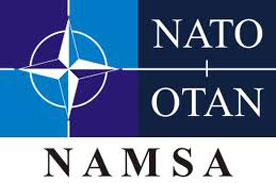NATO Maintenance and Supply Agency
- English
- French
The NATO Maintenance and Supply Agency (NAMSA), established in 1958, is the Alliance’s primary agency for in-service and operational logistics support. It provides this support to NATO or its member states individually or collectively.

Key customers are the 28 NATO countries. NAMSA also offers the means to provide effective support to NATO’s military authorities and its community of partner countries.
NAMSA is based in Capellen, Luxembourg, and has an operational centre in Taranto, Italy. A number of its staff are deployed to theatres and NATO commands to provide front-line support to operations.
-
Main tasks and responsibilities
NAMSA offers a variety of services that are constantly growing in number to meet evolving customers’ needs. The main service categories are:
- Supply - Provision of spares and equipment through central stock or procurement, initial provisioning, port services
- Maintenance - Repair and return, repair and direct exchange, depot level maintenance, overhaul, modification, calibration, on-site maintenance, contractor logistics support
- Transport - Strategic airlift, strategic sealift, materiel movement, consignment tracking
- Technical services - configuration management, engineering and technical documentation, engineering support and studies, civil engineering, system performance checks, software license management
- Operations support - Real-life support, unexploded ordnance clearing, environmental decontamination, infrastructure building and maintenance, medical support, airport of debarkation services
- Product life cycle support - Logistics support analysis, interactive electronic technical manuals
- Demilitarization - Elimination of ammunition, weapon and chemical stockpiles (primarily in Partner countries)
-
How it works in practice
While most logistics services are contracted out to industry, NAMSA fulfils the key role of a broker, controlling quality of the goods and services, managing the bidding process, administering contracts and ensuring logistics integration.
To achieve this role, NAMSA relies on three principles:- Consolidation - Uniting customers and their requirements facilitates cost reduction. Placing larger combined orders with suppliers and service providers leads to economies of scale and higher bargaining power.
- Centralization - Presenting one face to the customers avoids them having to deal with multiple suppliers and reduces their administrative burden. The same applies to suppliers who are expected to translate the reduced administrative load into lower costs.
- Competition - Organizing international competitive bidding helps the customer obtain the best service at the best price. It also allows suppliers to reach a wider market.
NAMSA does not compete with national procurement organizations, but complements them, filling existing gaps and offering to customers an extensive knowledge of the international defence market, earned over five decades. A database of certified suppliers is constantly updated (with more than 10 000 active suppliers) and contact with industry is complemented by the in-house expertise required for the selection of companies.
NAMSA’s advantages
According to its charter, NAMSA should provide services in the most cost-effective manner. It is a customer-funded agency, the “customers” being the member countries. Operating on a “no profit, no loss” basis, means that services are provided without any mark-up.
Consolidation, centralization and international competition allow for substantial savings for countries. NAMSA obtains lower prices for its customers and reduces their administrative costs.
Many NATO states see advantages in a collaborative approach with other Allies – particularly where this is more cost-effective than supporting their equipment individually. NAMSA aims to ensure that customers receive the best logistics support available to guarantee the operational readiness of their weapon and equipment systems.
-
Organization
NAMSA, headed by a General Manager, is organized into four directorates (Logistics Programmes and Operations, Procurement, Finance and Resources), each led by a Director.
The Agency is the executive arm of the NATO Maintenance and Supply Organization (NAMSO), which aims to achieve maximum effectiveness in logistics support at minimum cost to Allies – individually and collectively. All 28 Allied countries are represented in NAMSO, within which countries can form partnerships to manage the support of a specific weapon system.
The most common partnerships are the Weapon System Partnerships, consisting of two or more NAMSO countries and the Support Conferences, through which a group of national and Agency experts meet to arrange cooperation related to common weapon systems or equipment.
NAMSO is managed by a Board of Directors, which oversees the work of NAMSA. After consulting with the NATO Secretary General, NAMSO’s Board of Directors appoints the General Manager of NAMSA.
The Board, which reports to the North Atlantic Council, issues directives and makes general policy decisions to enable NAMSO to carry out its work. Its decisions on fundamental issues such as policy, finance, organization and establishment require unanimous agreement by all member states.
-
Evolution
NAMSO is a NATO Procurement, Logistics or Services Organization (NPLSO). It was established by the North Atlantic Council (NAC) in 1958 through the approval of the NAMSO Charter by the NAC. Initially based in France, NAMSA moved to Luxembourg in 1968.
Until the end of the 1980’s, NAMSA’s work focused on weapon system support. Modern tools, such as online ordering systems and the Internet, are used to expedite and facilitate communications with customers and suppliers.
With the end of the Cold War, NAMSA closely followed NATO’s transformation and began providing support to several NATO Initiatives, such as demilitarization projects in Partner countries (through Trust Funds), strategic airlift and strategic sealift.
NAMSA has also been assisting NATO-led operations, namely in the Balkans (IFOR, SFOR and KFOR) and in Afghanistan (ISAF). This assistance encompasses infrastructure, weapon system and troop support.
